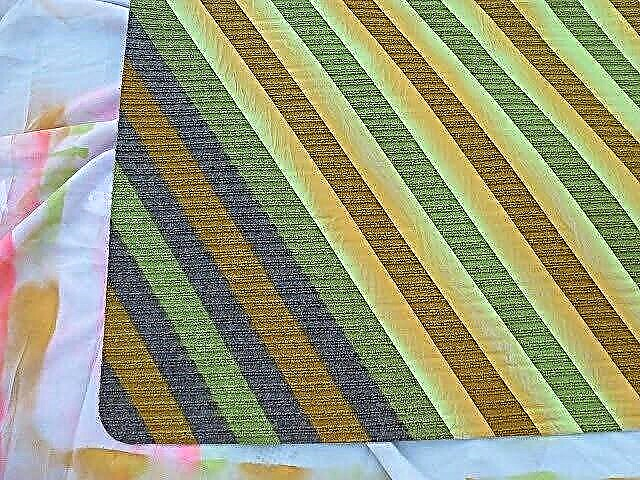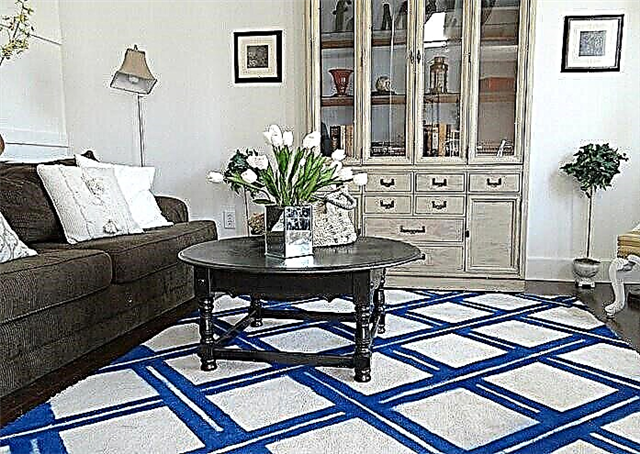Using paint, you can update the old carpet or decorate a new one. In our review - the basic rules of painting, stages of work, plus - ideas for updating different carpets.
Why paint the carpet?

Photo: redcedarhomes.com

Photo: tinykelsie.com
First, about why carpet painting might be needed. Here are a few reasons:
- the carpet faded in the sun and sometimes lost its color;
- spots appeared on the carpet that could not be washed in any way, I want to mask them;
- the color of the rug is disagreeable or not suitable for the new environment;
- I want to decorate the carpet, making it more interesting.
How to create comfort at home: 10 easy ways
What kind of carpet can I dye?

Photo: diynetwork.com
Before you begin, you need to find out whether it is possible in principle to paint the existing carpet. The fact is that you can paint carpets only with certain types of paints (more on this below), and these paints do not fall on all carpets.
Do not paint:
- antique carpets;
- handmade carpets;
- carpets with a very long pile (although in some cases such carpets can be painted, for example, if the rug is small and it is possible to saturate it well with paint for textiles, and then dry it).
Best colorable:
- carpets without pile or with short pile, carpets such as rugs;
- woolen carpets;
- nylon carpets;
- carpets made of cotton;
- carpets made of jute, sisal and similar natural materials.
We paint furniture: 5 main rules and a master class
How to paint a carpet?


Photo: abeautifulmess.com
Please note that paint suitable for carpets of one kind may not be suitable for carpets of another kind. Carefully read the information on the paint packaging and consult the seller in the store.
So, carpets can be painted:
- paint for textiles (liquid, spray or powder) - in this case, different dyes are needed for a carpet of natural and synthetic fibers;
- acrylic for textiles (even special acrylic for fabrics makes the material to be painted stiffer, so this option is suitable for carpets or rugs with a very short pile or without pile);
- resistant markers for fabric (it is clear that it is difficult to cover large surfaces with high-quality markers and for carpets with long pile this method is not suitable: this option is good for applying patterns to carpets without pile).

Photo: brit.co

Photo: twelveoeight.blogspot.ca
Depending on the type of paint and what your carpet is, the results of painting can be different. If you take paint for textiles (liquid or powder), then bright and dark colors will fall on a light carpet better and can only partially change the tone of a dark carpet. If you need to paint over spots, especially dark ones, it is better to use saturated colors. Acrylic patterns will cover a carpet of any color well, but can make it tougher. There are also acrylic paints with the addition of rubber, they are more elastic, the painted surface turns out to be slightly softer, but it is painted as good as simple acrylic - the appearance of the carpet can be completely changed.
Ideas for storage - interior baskets: 5 workshops
Carpet preparation

Photo: theorganisedhousewife.com.au
If the carpet is not new, before painting it must be properly cleaned (if possible, wash or wash) and dry. It is best to paint a dry carpet, but in some cases, wet painting is allowed (see the instructions for your paint).
Do-it-yourself carpets and rugs: 4 workshops and 20 ideas
Full carpet painting: master class


The method is suitable for carpets with both short and medium length pile. In the first case, you can use the roller, in the second, a spray is more preferable. Spray paint is suitable for carpet without pile or with a very short pile.
Step 1
Prepare the carpet for painting.
Step 2



If your paint is in powder, dilute it as indicated in the instructions. Liquid paint can be applied to the carpet using a roller or spray gun. If the paint is in the spray can, apply it to the carpet directly from it. Try to put the paint evenly. Cover the entire carpet.
Step 3
Leave the paint at the right time (see instructions), then, if necessary, wash the carpet and dry it.
Photo: designdazzle.com, tinykelsie.com
Handmade ideas from an interior designer: instagram of the week
Painting carpet patterns: master class

To apply patterns to the carpet, it is better to choose a paint that does not require subsequent rinsing - so the picture will turn out more clear. This method is more suitable for carpet without a pile or with a very short pile.
Step 1
Prepare the carpet for painting.
Step 2

Select a pattern. If you plan to paint the carpet with paint, you can pick up a stencil or, using tape or tape, protect areas of the carpet that are left without paint. The pattern with the help of markers can be applied directly by hand, before that, drawing borders.
Step 3



Apply paint to the carpet.
Step 3

Let the paint dry and remove the tape / electrical tape.
Photo: designimprovised.com
Options for painting carpets with patterns:
A simple stencil pattern enlivens plain mats:

Photo: homemadebycarmona.com
You can use the stencil to create large elements of the pattern, and add a contour with a marker or brush:

Photo: mountainmodernlife.com
Borders do not have to be clear:

Photo: thehousethatlarsbuilt.com
You can put not a picture, but the inscription:

Photo: pinkstripeysocks.com
Having picked up a suitable stencil, you can even apply quite thin patterns (paint spray is used here):


Photo: realitydaydream.com
As a stencil, you can use various improvised things (here ceramic tiles + wooden sticks + paint spray are used):


Photo: providenthomedesign.com
A plain carpet without lint can be decorated with even a rather complex pattern:


Photo: remodelaholic.com



